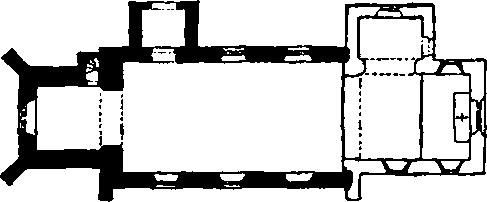An Inventory of the Historical Monuments in Dorset, Volume 1, West. Originally published by Her Majesty's Stationery Office, London, 1952.
This free content was digitised by double rekeying. All rights reserved.
'Beer Hackett', in An Inventory of the Historical Monuments in Dorset, Volume 1, West(London, 1952), British History Online https://prod.british-history.ac.uk/rchme/dorset/vol1/pp27-28 [accessed 17 April 2025].
'Beer Hackett', in An Inventory of the Historical Monuments in Dorset, Volume 1, West(London, 1952), British History Online, accessed April 17, 2025, https://prod.british-history.ac.uk/rchme/dorset/vol1/pp27-28.
"Beer Hackett". An Inventory of the Historical Monuments in Dorset, Volume 1, West. (London, 1952), British History Online. Web. 17 April 2025. https://prod.british-history.ac.uk/rchme/dorset/vol1/pp27-28.
In this section
6 BEER HACKETT (D.b.)
(O.S. 6 in. XI, S.E.)
Beer Hackett is a small parish 4 m. S.W. of Sherborne. The church is the principal monument.
Ecclesiastical
(1) Parish Church of St. Michael stands on the W. side of the parish. The walls are of local rubble and ashlar with dressings of the same material; the roofs are tiled. The Nave and West Tower were built in the first half of the 15th century. The North Porch was added early in the 16th century. The church has been drastically restored, the Chancel having been rebuilt, the nave largely refaced and the porch almost entirely rebuilt; the W. tower was rebuilt in 1897.
Architectural Description—The Chancel (17¾ ft. by 14 ft.) is modern but incorporates, in the N. and S. walls, parts of three 15th-century windows each of one cinque-foiled light.

The Church, Plan
The Nave (36 ft. by 18 ft.) has, in the N. wall, two windows, the eastern reset and of the 15th century and of two cinque-foiled lights with a quatrefoil in a two-centred head with moulded reveals and label with head-stops; the western window is modern; the 15th-century N. doorway has chamfered jambs and two-centred head. In the S. wall are three windows, the eastern and western reset and similar to the eastern window in the N. wall; the middle window is modern.
The West Tower (10 ft. square) is of the 15th century and is finished with a modern parapet with old gargoyles at the angles. The tower-arch is modern. The W. window is of three cinque-foiled lights with vertical tracery in a two-centred head with moulded reveals and label with head-stops. The second stage has a window of one trefoiled light in the N. wall and a window of one cinque-foiled light in the S. wall. The bell-chamber has, in the E. wall, a window of two trefoiled lights with tracery in a two-centred head; the N. and S. walls have each a window of one cinque-foiled light with a solid head.
The North Porch has a reset early 16th-century outer archway with moulded jambs and four-centred arch in a square head with foliage-spandrels and a label with returned stops.
Fittings—Bells; three; 1st by William Knight, 1745; 2nd from the Salisbury foundry, 15th-century and inscribed "Sancte Gabriel"; 3rd probably by W. Purdue I, 1572. Chest: In vestry—with enriched styles and panelled front, 17th-century. Consecration Crosses: Thirteen, all of a formy cross in a circle, (a) on reset stone near N.E. angle of chancel; (b and c) on external jambs of S. windows of chancel; (d and e) on jamb and sill of S.E. window of nave; (f) on external face of stair-turret of tower; (g and h) on reset stones of tower-arch; (i) on internal sill of W. window; (j, k, l and m) on internal and external jambs of W. window. Font: octagonal panelled bowl with moulded edge and angles, splayed underside with small cusped panels and two panels with foliage, plain stem and moulded base, 15th-century. Glass: In W. window of porch—shield of the arms of Sherborne Abbey, 15th-century. Plate: includes a pewter alms-dish, late 17th-century. Miscellanea: Loose in tower—15th-century head-corbel.
Secular
(2) Bridge, about ½ m. W. of the church, is a rubble structure partly ashlar-faced and of three spans. The ashlar-faced piers with cut-waters may be of the 16th century, but the superstructure, including the central elliptical arch and the two semi-circular side-arches, is not earlier than the 18th century.
Monuments (3–9)
The following monuments, unless otherwise described, are of the 17th century and of two storeys. The walls are of rubble and the roofs are thatched or covered with modern materials. Some of the buildings have exposed ceiling-beams and original fireplaces.
(3) House, on the N.E. side of the road 270 yards N.W. of the church.
(4) Lower Farm, houses 130 yards W.N.W. of the church, was restored and altered in 1735, the date with the initials I. and A.M. appearing on the W. front. The same front retains some original stone-mullioned windows, the lower ones with labels.
(5) House, 30 yards N.E. of the church, was built probably c. 1700, but has been much altered.
(6) Higher Farm, houses opposite (5), is of similar date and build to (5).
(7) Claypits Farm, house ½ m. E.N.E. of the church, was built early in the 18th century. In the garden is an iron fire-back dated 1704.
(8) Lower Farm, Knighton, house 600 yards S.E. of (7), built in the 16th century, retains two original muntin and plank partitions and a door of grooved battens.
(9) Cottage, on the N. side of the road 300 yards E. of (8).